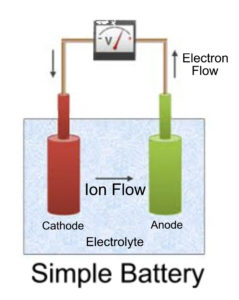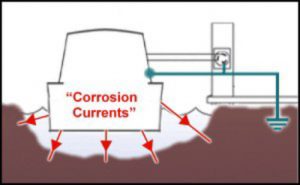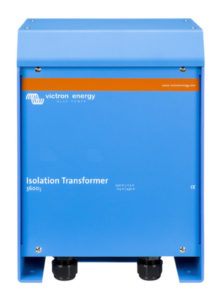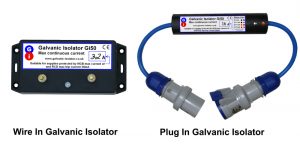Italian Luigi Galvani knew very little about narrowboats – even though he was born in the early 1700’s, just a few years after the Main Man, Mr. James Brindley.
 Luigi, if you recall, was the chap who liked to watch frogs legs twitch when an electric current was attached to them. At the time, this phenomenon became known as “Animal Electricity”, but eventually, the name “Galvanism” took over.
Luigi, if you recall, was the chap who liked to watch frogs legs twitch when an electric current was attached to them. At the time, this phenomenon became known as “Animal Electricity”, but eventually, the name “Galvanism” took over.
Galvanism also became the name for electricity generated by chemical means, and is the foundation on which the batteries on our boats work. So the next time you turn your ignition key, and the engine springs into life, think of….. FROGS.
Skipping over the theory a little, we can say that Galvanic Current, (aka Galvanism) results from two pieces of metal being submerged in a liquid, (which nerds like me call an electrolyte).
A fundamental law of physics is that whenever two different metals are submerged in an electrolyte, a voltage always appears between them.
 Generally, our boats are made of steel – or aluminium. And they are immersed (hopefully only partially) in water. So we have two of the components required to make a simple battery. All we are missing from our Galvanic Current Generator (aka Battery), is a second piece of immersed metal. This is supplied in the form of pontoons or submerged metalwork, other boats, or the bankside which of course is laden with minerals.
Generally, our boats are made of steel – or aluminium. And they are immersed (hopefully only partially) in water. So we have two of the components required to make a simple battery. All we are missing from our Galvanic Current Generator (aka Battery), is a second piece of immersed metal. This is supplied in the form of pontoons or submerged metalwork, other boats, or the bankside which of course is laden with minerals.
You can confirm this for yourself by knocking a spike into the ground and, with the mains cable disconnected, wire a sensitive multimeter on the 2 Volt range between the spike, and the hull of your boat. You’ll measure a small fraction of a Volt. This is the Galvanic Voltage we’ve discussed.
Unfortunately, this Galvanic Voltage isn’t sufficient to boil a kettle, or even charge your ‘phone. But it IS more than enough to erode your boat’s anodes, hull, propeller etc.
 This erosion can only happen if your boat is connected to a shore based mains supply. That’s because although there’s always a Galvanic Voltage, it still needs a path to complete the circuit (or no current can flow). The earth conductor in your mains cable completes the circuit.
This erosion can only happen if your boat is connected to a shore based mains supply. That’s because although there’s always a Galvanic Voltage, it still needs a path to complete the circuit (or no current can flow). The earth conductor in your mains cable completes the circuit.
To avoid these Galvanic Currents flowing, we need a way to isolate the boat from the mains earth. This will break the circuit for the Galvanic Current. But for safety’s sake, we can’t just disconnect the earth connection. In fact, don’t even THINK about disconnecting the earth connection.
There are two ways to isolate your boat from the mains earth. One is to use an Isolation Transformer. This is a perfectly valid way of achieving DC isolation, (but please don’t be mislead into believing that you have an earth-free system, because there will still be a path to earth through the boat’s hull).
Isolation Transformer:
 If you choose an isolation transformer, it should be rated at around 5KW for a 16A supply, otherwise, you could find that fridges, washing machines etc struggle to start up.
If you choose an isolation transformer, it should be rated at around 5KW for a 16A supply, otherwise, you could find that fridges, washing machines etc struggle to start up.
Also, ensure that the transformer is rated for an adequate duty cycle, depending on the load. Many isolation transformers are rated for intermittent duty cycle, and could easily overheat.
Galvanic Isolators provide isolation in a different way – by using semiconductors to block small Galvanic Voltages, whilst allowing larger “fault currents” to flow. In that way, the safety electrical earth is maintained – which is EXACTLY what we want.
So which Galvanic Isolator do you need?
 Basically, there are two types – Plug in and Wire in. The wire in ones are connected permanently inside the boat. It’s a simple job – provided you can access the wiring.
Basically, there are two types – Plug in and Wire in. The wire in ones are connected permanently inside the boat. It’s a simple job – provided you can access the wiring.
Plug in types – as the name suggests – simply plug into the mains inlet of the boat. The BIG advantage is that there is absolutely no possibility of wiring errors.
You choose your Galvanic Isolator based purely on the capacity of your shore supply. There is NO advantage in buying the “Biggest” galvanic isolator you can find. A 32a isolator is not “Stronger” or more “Powerful” than a 16a one! So if you have a 16a supply, choose a 16a isolator. If you have a 32a supply, then it’s a 32a isolator that you’ll need.
How to choose…
For excellent BASIC protection, our Gi50 isolators represent fantastic value. They are guaranteed to stop Galvanic Currents from flowing along your shore line’s earth conductor. The Plug In version is HERE. And the wire in version is HERE.
However, most people are also (rightly) concerned about Earth Leakage, which can be even more devastating than Galvanic Currents. For ULTIMATE protection, choose our Gi50/SA models. Plug in HERE, and Wire in HERE.
If you’re buying a plug in isolator, you absolutely MUST buy the correct size, or the plugs won’t physically fit. A 16a plug won’t go into a 32a socket, or vice-versa!
 If you’re not sure of the capacity of your supply, there are a couple of easy ways to check, though in the VAST majority of cases, it will be 16A.
If you’re not sure of the capacity of your supply, there are a couple of easy ways to check, though in the VAST majority of cases, it will be 16A.
1) Look at the circuit breaker on the supply post. There will be a number printed on or close to the switch that tells you the current rating of the circuit breaker. That is the capacity of your supply.
2) Measure the plug on your connecting cable. If the outside diameter is around 42mm (Just over 1.5”), it’s 16a. (32a plugs are considerably larger at approx 57mm (about 2.25” diameter).
Click HERE for Part 2


